In Justin Lovell’s upcoming independent short film The Cloud Train, an unexpected foot chase through a futuristic cityscape leads our protagonist to discover more about the world – and perhaps about himself. The short is a passion project, taking inspiration from Lovell’s love of animation across eras and continents. Lovell, who has been part of Emmy, Annie and BAFTA award-winning productions, also hopes that The Cloud Train will lead to more original creator-driven projects in animation.
The Cloud Train currently exists as a 90-second extended proof-of-concept trailer, produced with support from Atomic Cartoons and Toon Boom Animation. The in-progress film is a love letter to the craft of traditional animation which also showcases new features introduced in Storyboard Pro 24 and Harmony 24. Toon Boom Animation provided technical support and sponsored the creation of the trailer, and artists learning workflows in the software will be able to add techniques to their repertoire by following along with downloadable scenes inspired by the project.
We interviewed Justin Lovell (creator, director and animator) as well as three creative leads on the project, Jouchelle Miranda (storyboard artist), Elton Su (2DFX lead) and Shannon Hamilton (compositing lead) about their experiences on the project so far.
How would you describe The Cloud Train? And what makes this project different from other projects that you worked on in the past?
Justin: The Cloud Train is a hand-drawn short film that I came up with about 15 years ago. It’s something I’ve always wanted to get back to. And what makes it different is there’s no one telling us what to do. We were a bunch of creatives being creative. I’ve been very blessed to have these amazing, talented artists around me. And we certainly push the bar as far as quality and what an indie project could look like.
We’re just trying to impress ourselves. If Elton did a crazy effects or lighting pass, I’m sharing that out to the group. Shannon recently dropped an amazing comp frame and I was just blown away. And I was passing that out to the group. So as a team, we’re just trying to outdo ourselves. I think that’s so important.
We don’t have to be worried about: “Is this going to fit into a certain category for X amount of viewers?” “Are we trying to get the broadest range?” No, we’re just doing creative things because we love doing what we want to do. And I think that we’re seeing that the final product really speaks to what we’re trying to achieve.
Jouchelle: I would echo a lot of what Justin said. It’s getting to play around a bit more. We’re not as limited to the studio pipeline. From a storyboarding standpoint, I think having the rotating shot in a 2D film is pretty unique and ambitious. And that was a really fun one to do. That was my first time doing that. And yeah, it’s a cute short.
Elton: All of the other productions I’ve worked on usually use rigged animations. This one is all hand drawn, which I really enjoyed. It does make the whole file a lot lighter. It does make things easier to put the 2DFX on since I’m pretty much masking my effects onto the characters. And I can play around with different shapes to make the volume pop out a lot more.
Shannon: Yeah, just to piggyback off of what Elton just said, the fact that it’s hand drawn, and we were all used to both complicated and simple character rigs. So for compositing, in that sense, we were able to just create light shapes, and then parent that to the existing drawing with keyframe information. You can’t do that here with a hand drawn animation, you have to actually paint things frame by frame.
So luckily, we have someone like Elton who can take care of that on his end. And then I can take his shapes and then make it look as pretty as possible. So it’s been very interesting to work on.
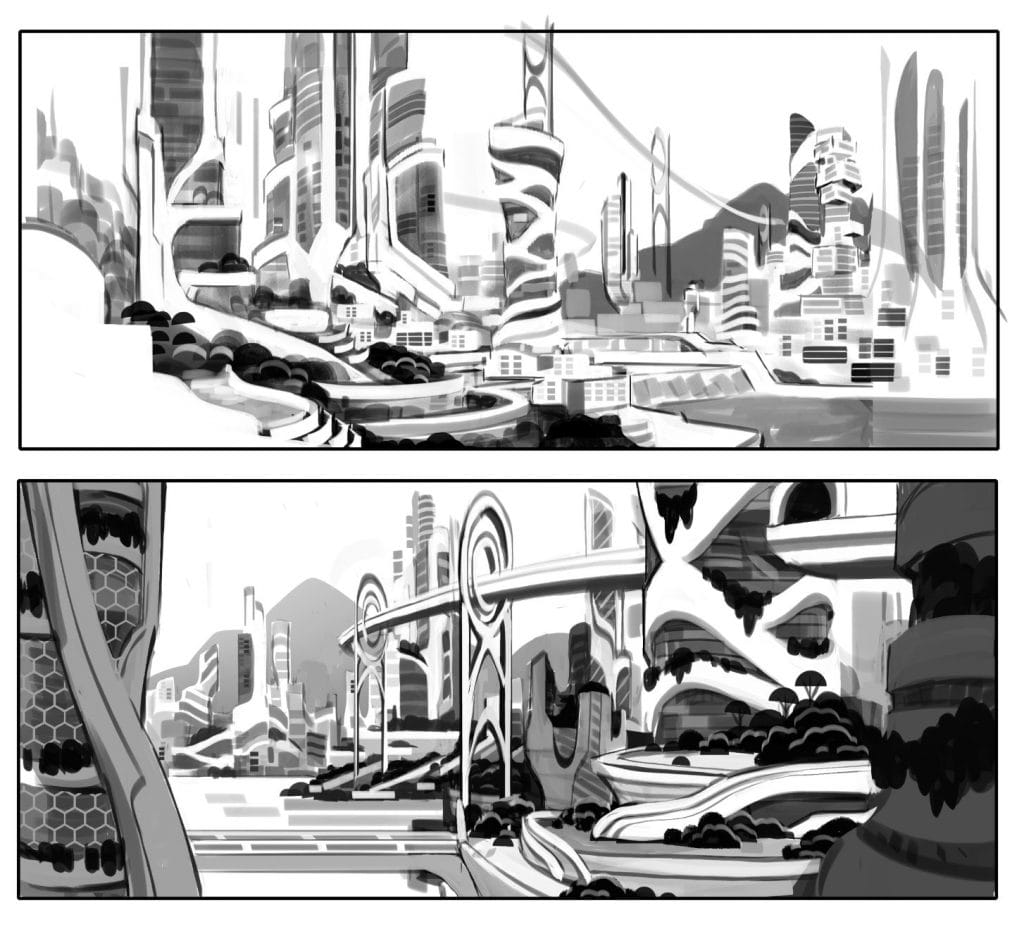
Given the state of the industry, do you think indie projects are going to become more common?
Justin: I’m really hoping that we get away from this idea of we’re only going to buy franchised media. Let’s use superhero movies as an example. They were really hot when they first came out, but now the sales that I’ve seen are going down because we’re a bit fatigued.
I think the industry needs to really take a good look at that and ask, “Maybe we need to support more original IP? Maybe we need to start pushing original ideas from new creators?” I would like to hope that in the next five to ten years, we see a huge swing in what people want to get behind. I think the push for original content will start to come because we’re starting to hit that plateau of recycling the same stories in a different medium.
What was your experience in the animation industry before you started on The Cloud Train?
Justin: My first full time gig was at Walt Disney Australia, where I kind of climbed my way up from in-betweener to rough character animator. Then after Australia, I was in Vancouver for a year, back to Australia where I was at Flying Bark. And then I flew back to Canada to work at Mercury Filmworks. Now I’m here in Vancouver, where I’ve worked up from animator to animation supervisor — to animation director. Now I’m directing a Disney+ 3D project, and it has been very interesting to leave my roots and jump into an extra dimension!
Every major studio I went to, I was able to incorporate their style into my own. I’ve been able to kind of fuse a lot of everyone’s techniques, and just evolve. I’ve been very fortunate to be able to fly to and live in other countries, from New Zealand, and continue doing what I am super passionate about; which is telling stories through the medium of animation.
Jouchelle: I graduated in 2015, and then I actually went into a more technical role as a flash builder. Then I became a build lead before realizing that I wanted to switch to a more creative role. I became a storyboard artist in 2017, and I’ve been working in storyboards ever since. Primarily in action boards, on shows ranging from pre-K to pre-teen.
So I was very familiar with dynamic chases. Working in 3D space was also something I was very familiar with, but merging the two together was a bit different for me. Since working on The Cloud Train, I’ve worked my way to story director.
Elton: For me, I started when the pandemic hit. So it was a wild time. So usually it’s kind of hard to find a job. But I was lucky to land a job at Kapow Pictures, which is doing a Steve Irwin-type animated series. That was a really fun opportunity.
And because of that, I was actually able to work for Justin at Atomic as a freelancer, which led me to coming over from Australia to Vancouver. And now I’ve been at Atomic Cartoons, Titmouse, and now back to Atomic Cartoons. I’ve also been working part-time at Flying Bark as well.
Shannon: I started out actually as a visual effects artist for live action and 3D. Back in Atlanta, in 2012, my very first gig was an Adult Swim show. It was live-action with 3D backgrounds and a lot of green screen. Then I went on to Cartoon Network and a couple other Adult Swim shows that were mostly 2D — like Aqua Teen Hunger Force, Squidbillies, those types of shows — which were pretty funny. And they were fun to work on. I also went to Floyd County, where I worked on Archer for a bit.
After a while, I couldn’t find too much work [in the US], so I was recruited to Canada to work on the My Little Pony movie back in 2017. And that’s where I met most of the people over there at Wildbrain. I was there for about seven years, working my way up to a comp supervisor on Carmen Sandiego. And then I believe I met Justin at Atomic Cartoons on Night at the Museum: Kahmunrah Rises Again. And that’s where it all started. Once that contract was done, my visa was up and I ended up back here in the US.
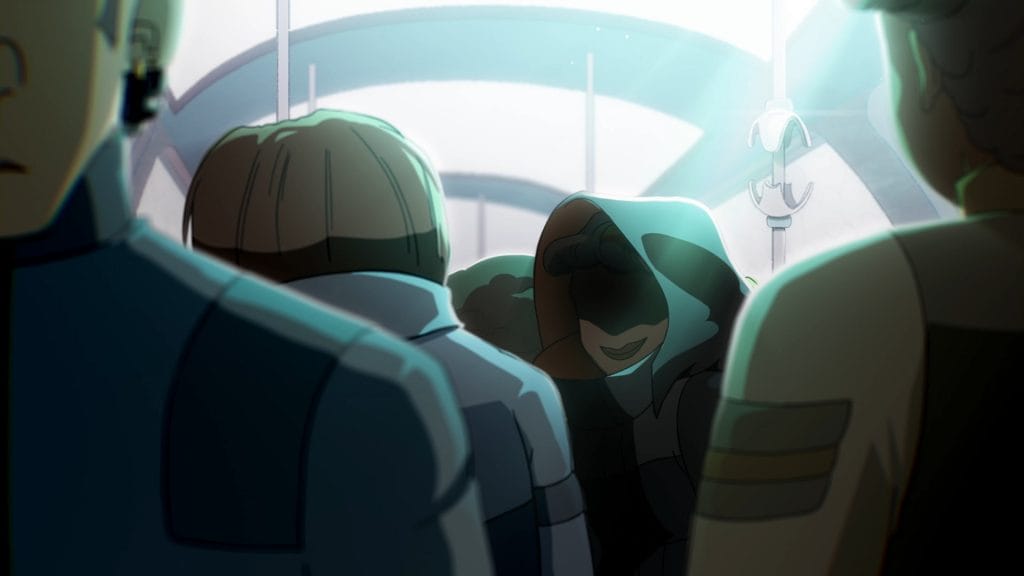
What prompted you to work on The Cloud Train?
Justin: It was a couple of things. I’ve been working on this film for the last twelve-ish years. I put it down for a while, because I’d done a couple of short films and they’d been misses. I really needed to work on my storytelling skills, and so that’s what I did. Once I got to Atomic Cartoons, and I started moving up the ladder, I started broadening my horizons as far as how to tell stories. I think it was around Night at the Museum: Kahmunrah Rises Again when I was like, “I feel like I’m in a good spot.”
So we got a team together. We got the boards together. We got designs, environments, we got everything thrown together. Then it was just a matter of finding the time myself to do some line tests — to get the animation where I was happy with it. There was a lot of collaboration with artists.
As far as the timing [of the project], I miss hand-drawn so much that I was like, “Well, why not now?” We have all these amazing, talented people out in the world that potentially are looking for jobs, looking for something to do. A lot of younger animators haven’t had the chance to do hand-drawn animation, so there’s now a path that they potentially could take to get a bit of a taste of what it would be like to work on a hand-drawn film or series. Unfortunately, hand-drawn is not, not really the norm at this point.
The focus of the scene from The Cloud Train is a chase. What are some of the opportunities in your craft that a chase scene presents?
Justin: The characters’ personalities will define their choices and how they move, how they react to things, what obstacles they will try to get over, which paths they want to take, and where they feel safe. Having a mindset of being able to get that action, but also seeing reactions through anger to realization to maybe even flirtation, having those story beats in place, and having someone know how to project that with the characters is super important. Not just any animator could pick something up like this.
I think chase scenes resonate with all of us on a primal level, whether it’s as kids running around playing tag or other sports. Usually with our action sequence, we’d like to keep them pretty quick and make sure the energy stays up. But this one, I decided that maybe we don’t want to make so many cuts, and we want to just do something extraordinarily difficult. But honestly, it’s paying off in dividends.
The response I get is, “Why are you doing that? That looks too difficult.” When you hear so many people say “this can’t be done,” it becomes a bit of a challenge. And then from challenge, we see innovation. We get creative with our choices. So we’re able to visually push the storytelling and I think that’s why a lot of this stuff, hopefully, will resonate with people. It will hit a nerve with them in a positive way.
Jouchelle: I love planning out choreo. You really can’t just have [both characters] straight in front of each other. That gets pretty boring to watch right away. Especially with this sequence, Justin kind of pitched it as a ‘chase dance,’ an interactive thing. I was like, “All right, sure.” Trying to go from that seriousness to playfulness, that transition as you’re like running through this train, was an interesting acting line to have, making sure that their motivations are clear. He is still trying to chase her, but they’re kind of having fun.
Then there’s the added complexity of the camera. You have to choreograph everybody to be facing the right direction at the right times. There’s a lot of complexity with this. I definitely go deep into programs that I use, and I think that really benefits how I board. And it makes my job easier. With this short, Justin didn’t ask me to 3D model anything, but when I was boarding and I knew I had to do this rotating shot, I went ahead and just roughed it out for myself. That way, I could be a bit lazy and not draw the background, I could just use this rotating Blender file instead.
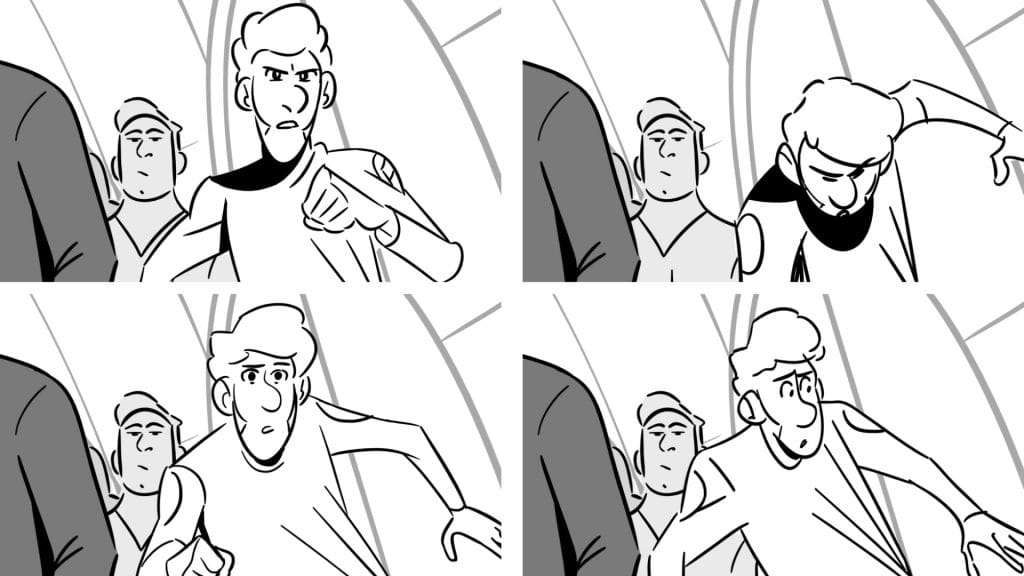
I think you’re the first person to ever say: “I was lazy, so I created a 3d model of the entire scene.”
Shannon: As far as compositing is concerned, it’s adding lights and shadows. I feel like in a chase scene you have to put in a lot of work to get in some really dynamic looking shadows in those poses. But luckily, we have our talented FX artists, taking a lot of that weight off my shoulders. So I can concentrate on the rest of the comp and then just make his stuff look pretty.
The dynamic posing, the lighting, the motion blur, adding in all the different layers, especially for the 3D rotating scene that we have going on, there’s a lot of intertwining; layers that need to be like in front the characters and whatnot. It’s quite the work to handle but it’s very exciting. Once you see the final product, it’s just so rewarding.
Elton: With the characters moving through the train, I was able to play with the highlights so much more. Because the characters are moving through different areas and lighting. I was able to kind of have them pass through the lighting, going from the front to the back of the characters. When I replayed it, it looked really nice as a smooth transition.
What was your approach to traditional animation in Harmony? Did you draw using a tablet or scan your roughs?
Justin: I wish! I don’t know if I want to sit here punching reams of paper for us to go super old-school. We don’t have the time. We used Storyboard Pro to do the boards, and we are using Toon Boom Harmony to do both the animation, the comp, the lighting, the effects. We’ll go all in with Toon Boom products.
I want to take everything that I did at Disney, everything that I loved about hand-drawn, and bring it into the software. So, it’ll all be hand-drawn. We’re doing roughs. We’ll do cleanup and colour. All of that will be in the animation pipeline, as if it was hand-drawn pencil and paper, but it’ll just be within the program itself.
We’ve modernized a very old way of doing animation, but I feel like we still capture that nostalgia. We still get to see that craftsmanship in every frame, which is super important to me. It’s not just an art. It’s something that you can learn, you can get better at, and you can master your craft. And there’s a desire for it. I can see it in the way that media is going. I think people are looking for deeper stories, but something that resonates with them visually. That’s what I’m hoping to get: people being like, “This is new, but it feels like something that I’ve seen before.”
I’ve taken so much inspiration from Miyazaki and the quality of films we used to get back in the golden age of the 90s with Disney features. So I’m literally just trying to take everything we can and just kind of smash it into one project. If it resonates with the artist, hopefully it would resonate with the viewers as well.
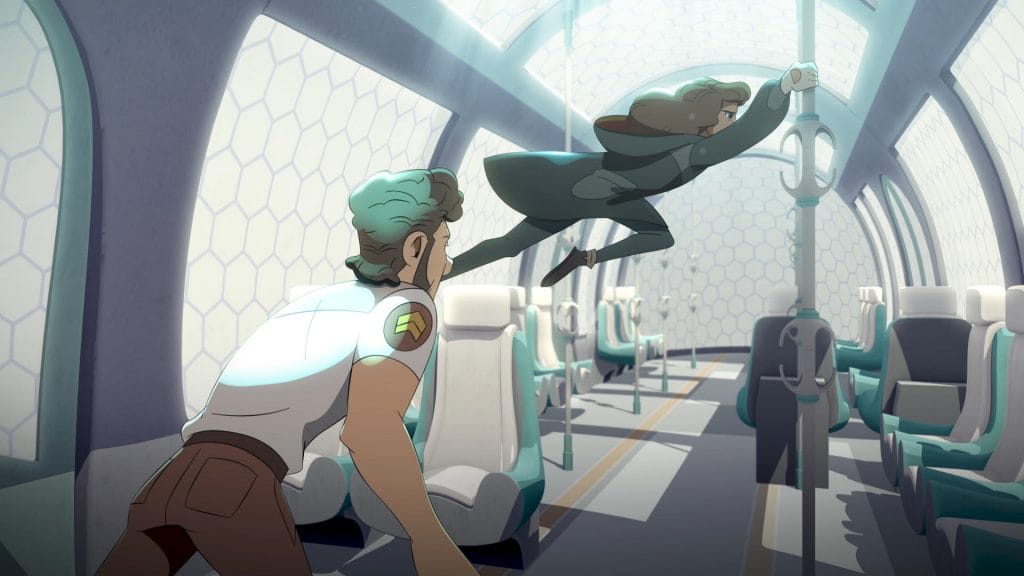
I’m glad you brought up Miyazaki, because it’s very clear even from the Kickstarter that Cloud Train takes influence from Studio Ghibli.
Justin: Anime is what got me into this industry. I watched Dragon Ball, and I just thought: “People get paid to draw this? Maybe that’s something I can do.” And then from there, that just exploded. I found Miyazaki’s work. Lupin III was a huge inspiration for this one. And then My Neighbor Totoro to Spirited Away, Princess Mononoke… the list goes on. We’re all kind of mesmerized when we watch his work. It’s hard not to be inspired by someone who’s such a master of their craft.
It’s the way he goes about his storytelling, and the amount of love and passion he puts into his work. So it’s inspiring for a lot of us. And I think even his latest film being up for so many awards shows that the general public are looking for something different than what has been the norm for so long.
What were some of the challenges and accomplishments that you’ve encountered while working on the cloud train so far?
Jouchelle: Um, accomplishments… It’s that we just managed to do it? I think we pulled it off. The rotation following the characters, keeping that playfulness, but then also giving the characters nuance all throughout. I would chalk that up as a huge success.
The challenges would just be the shot itself. I’m used to using Blender, just screencapping a background and then dropping in. I never did a deep dive in it. And so then for this short I actually went in and learned how to like keyframe animate things a little bit.
I modeled the train, and then I roughly blocked out the characters and then animated their choreo as they go through the train. And I’m talking really basic blocking. Like, they’re triangles and cylinders at this point. I just wanted to make sure I had that choreo of how they move through the train and how they rotated around each other, making sure I had enough pauses and knowing where certain moments would be.
And then I would go in and I had to export it out twice, once with just the backgrounds themselves. And then once with the blocking. That way, I could see the consistency of my characters. Then as I go into Storyboard Pro, and draw characters in, I could turn off that layer and I would have a clean background.
Elton: I think a lot of what inspires me [for lighting FX] is actually from anime, because they always have really interesting shapes. And in some of the really huge action scenes you see, every frame is basically an illustration. So I was trying to kind of replicate that by playing around with the light.
Shannon: As far as challenges, I would have to piggyback a little bit off of what Elton said with light shapes and shadow shapes. In the earlier scenes, I was the one actually putting some of that together onto the characters. Once we got to the more complicated scenes, and seeing what Elton did, to me, I was just like, “Oh, thank God. He’s able to do this.” Just looking at the train shot, just watching all the highlights just roll off the characters, it just makes me so excited to add gradients to it and make it look nice and pretty.
As far as challenges, though, the only real challenge is just time. Everything is time consuming. Even when moving a gradient on a character, I have to track that gradient to the character’s head for every single frame. So yeah, it’s just time consuming, which is why I’m very appreciative that we have so many people on this team that can help out and make these things a lot easier. Especially since we’re doing hand drawn animation.
Justin: Probably the big chase scene. I’m very thankful that we got to tackle this because it was a six-month long monster that I think I was going to tackle myself. So I think the biggest challenge with that shot specifically, was just getting everyone on board because of how big it is. Then just making sure that we’re keeping these characters on-model that the hookups are there. We’ve had to be very careful about where we’ve parted the shots, we ended up separating into two teams.
So we have the female lead, and the male lead, and both teams had about two-to-three animators on each side. That was the biggest challenge. But also the biggest reward was watching it all start to come together; starting to see the cleans the colors, having Elton go through and do these highlights. And now we’re starting to see Shannon put everything together in comp. Even at the storyboard stage, Jouchelle had said it was a big undertaking.
I don’t think we could have done it without the right people at the right time to lift this massive challenge of a shot up. We’re definitely very fortunate to have the team that we’ve had and everyone really just rising to the challenge. That was that shot, so with that being done now it should be smooth sailing, right?
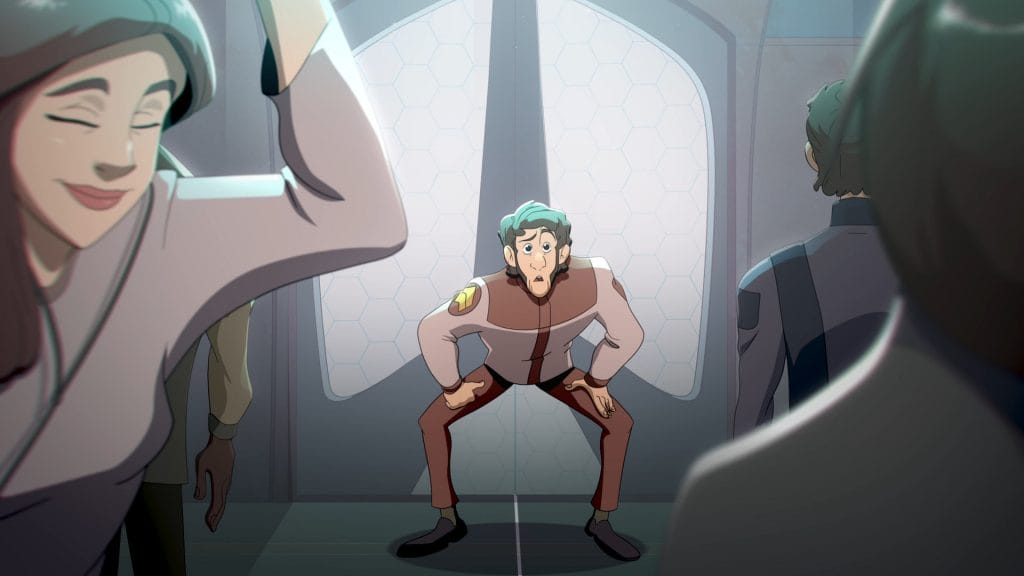
You partnered with Toon Boom Animation to use scenes from The Cloud Train to demonstrate features new to Storyboard Pro 24 and Harmony 24. What interested you and your team in collaborating with Toon Boom Animation and Atomic Cartoons?
Justin: Honestly, being able to have Toon Boom Animation come to the table and supply us with the correct tools that we needed to do something this outrageous. I don’t think any indie film has tried to do what we’re trying to do, which hopefully sets us up for success.
So they were able to give us the tools we needed. And Atomic Cartoons was very nice about lending us support on the production side; making sure that shots were where they needed to be and making sure artist management was kept up and everyone was sticking true to deadlines and everything else. We were very fortunate to work with two amazing partners that helped us execute this to the standard of what we’re currently doing.
Is there a feature in Harmony or Storyboard Pro, either old or new, that you think artists should be more aware of?
Justin: Having the 3D features, we can play with the camera. And that is so important today. I’ve been in a role in the 3D world for over a year now and being able to move around and change positions of that camera really brings a character to life just by slightly changing things.
And now we have the opportunity to do that with 2D, which is phenomenal. Being able to set the parameter and say, “maybe we can drop the camera and make it a shot a bit more heroic, maybe make the character have a bit more distance to feel a bit more alone.” Yeah, I’m all about 3D integration in Toon Boom Harmony.
Jouchelle: Definitely what Justin was saying. I wish that the new features existed back when I was actually boarding this.
If you’re setting up a scene that you’re about to board, you can set Storyboard Pro up so every new scene that you make, and every new panel you make, has your set default layers. So if you’re making a scene with me and Justin and a background, you can set those up at the start. And then they’re there throughout the whole board.
It seems like a small detail. But if you had to click buttons and type in “Character_A,”
“Character_B”, and “Background” a thousand times, that would add up.
Jouchelle: It would take a lot of time!
Elton: What’s not to love about Harmony, honestly? I’ve used a lot of animation programs, but the one thing I love most about Harmony is the node view. The ability to connect things here and there to create the effect that you want to make is absolutely amazing. Rather than shuffling layers to one above or one below. And then having that Z-axis view as well allows you to move things back and forth throughout the scene.
Do you have any advice on keeping the node view from looking like spaghetti?
Elton: I mainly just keep things as organized as possible. So with the effects added, let’s say I have a shadow effect or the character for all the effects for the male character — I put them all into a backdrop. So then it’s all kept nice and tidy within the box.
Shannon: The Node View is every comp artist’s dream. We love to just plug and play certain things, so we rarely ever use the timeline at all. But just to talk about organization, now there are a couple of buttons at the top of the Node View that allow you to realign everything automatically. It’s the best thing ever for organization for OCD. You couldn’t have asked for anything better.
What’s next for The Cloud Train?
Justin: We are taking the trailer to Annecy, which I’m super excited about, and hopefully generating some buzz. We’re just getting the word out of what we’re trying to produce, what we’re trying to do. And just gain some support for the film itself. We’ve got a minute-and-a-half of footage already and we’ve got five minutes to go. We’ve all put so much hard work into this film already, and it would be a bit of a shame if we weren’t able to complete it. So what’s next? We are hoping to wrap it up.
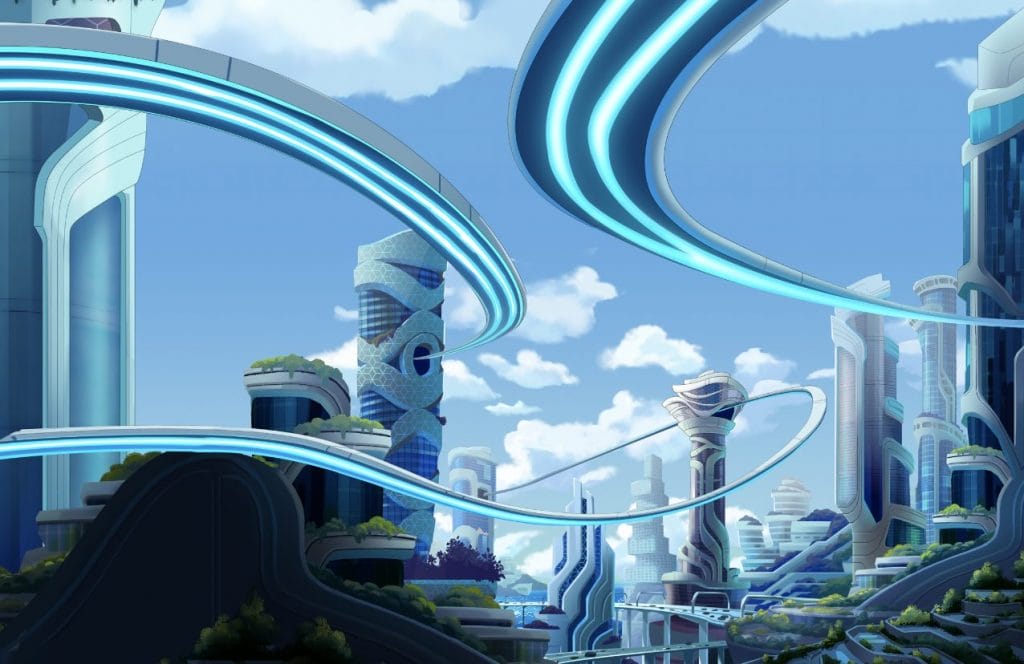
Do you have advice for artists interested in working on independent projects?
Justin: Just do it. I’ve been working at this one for fifteen years. And we’ve finally got a trailer that’s going to be released soon. So don’t let people say you can’t do something. And it’s okay to fail every once in a while, to grow and learn. Don’t let those things kind of hold you back from doing something.
If you want to do an indie film, or you’ve got something creative you want to push, just be persistent with it. You can put it down for a little bit, but pick it back up when things get slower and you need a change of pace. Don’t be someone that says, “Hi, I have this project, and I never do anything with it.” Just throw yourself at it. And slowly chip away.
Jouchelle: Go for any project, even if you don’t think you’re fully ready for it. Mainly because you can learn a lot on a project. And if you always wait, like if I said no to Justin’s project, like “I’ve never done this shot before” or “I could never do the sequence,” then I wouldn’t have gotten that experience. And I think it turned out really well because I felt more dedicated to learning it for the outcome. So I think waiting until you’re fully ready for something never really works. You just gotta go for it!
Elton: One thing I’ve learned is time management. Being able to commit a certain amount of time on your personal projects after work is really important since, if you don’t have that kind of commitment to it, you’re kind of putting it on the back burner. And sometimes you’ll forget about it. And then slowly, it becomes something that’s not getting done.
But if you’re persistent about it, you will improve. As your skills improve, everything about your project will be more interesting. When I first started my personal project in 2020, my drawing skills weren’t as great. And right now I can see myself drawing things so much better. Everything’s improved. And it’s given me that urge to continue working on those projects as well.
Shannon: Don’t limit yourself. If there’s anything that you’re very adamant on doing, go ahead and just do it. Accept the challenge. That’s what I love doing. I love a challenge. Take breaks, don’t burn yourself out. But also don’t forget it either. Because at the end of the day, if you take too long, then you’re probably not going to pick it back up. I would just say just take the challenge and just don’t limit yourself or your creativity.
- Want to help Justin Lovell get The Cloud Train on-track? Support the project on Kickstarter.
- Interested in seeing how Storyboard Pro 24 and Harmony 24 can help you make your independent film a reality? See what’s new.
The post Justin Lovell on the journey behind The Cloud Train appeared first on Toon Boom Animation.
Courtesy: https://www.toonboom.com/justin-lovell-on-the-journey-behind-the-cloud-train






